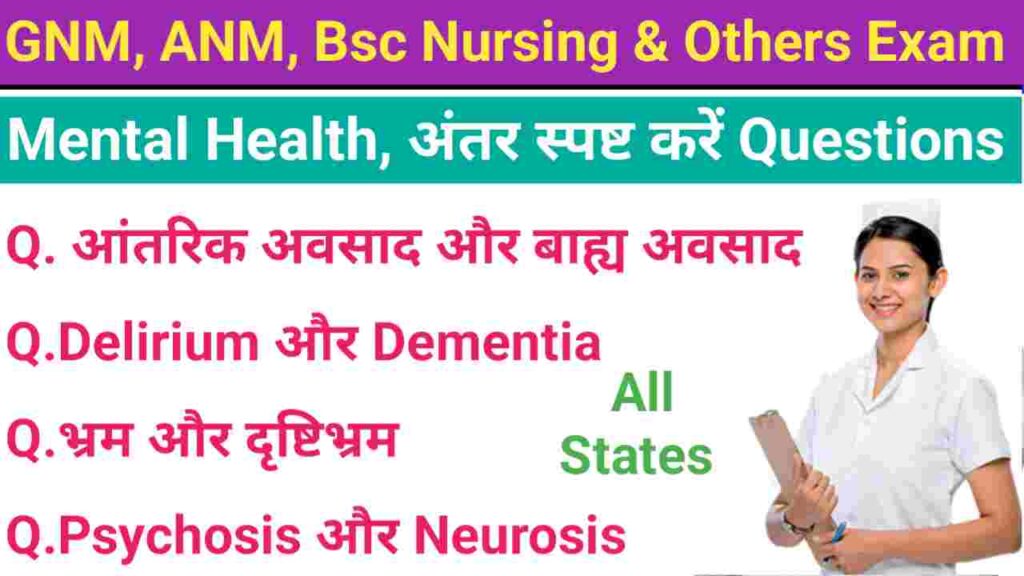mental health nursing differences for GNM 2nd Year, ANM, Bsc Nursing & Others, अन्तर स्पष्ट करें से संबंधित प्रशन।
mental health nursing differences for GNM 2nd Year, ANM, Bsc Nursing & Others, अन्तर स्पष्ट करें से संबंधित प्रशन।
mental health nursing differences is mental health nursing difficult differences between mental health nursing and psychology difference between mental health nursing different types of mental health nursing different areas of mental health nursing types of mental health nurses is mental health nursing the same as psychiatric nursing
mental health nursing gnm 2nd year pdf download mental health nursing gnm 2nd year mental health nursing gnm 2nd year important questions, mental health nursing gnm 2nd year syllabus pdf mental health nursing gnm 2nd year book mental health nursing gnm 2nd year book pdf mental health nursing gnm 2nd year question paper mental health nursing gnm 2nd year important questions and answers mental health nursing gnm mental health nursing gnm 2nd year important questions

अस्थाई मानसिक गड़बड़ी एवं मनोभ्रंश में अन्तर (Difference between Delirium and Dementia)
अस्थाई मानसिक गड़बड़ी अथवा सन्निपात
(Delirium or Acute OBC)
1. इसका हमला अचानक से होता है
2. इसकी अवधि कम होती है।
3. सोचने व समझने की शक्ति कम हो जाती है।
4. भ्रांतियां पाई जाती हैं।
5. अभिविन्यास में गड़बड़ी।
6. रोगी थोड़ी देर पहले हुई घटनाओं को भूल जाता है।
7. चेतनता पर प्रभाव पड़ता है।
8. कम्पन्न होता है।
9. सोने और जागने का क्रम बिगड़ जाता है।
10. EEG विस्तारित होती है।
11. एपैशिया और एप्रैक्सिया का न पाया जाना।
12. प्राथमिक कारण का उपचार किया जाता है।
1. Its attack occurs suddenly
2. Its duration is short.
3. The power to think and understand decreases.
4. Misconceptions are found.
5. Disturbance in orientation.
6. The patient forgets the events that happened some time ago.
7. Affects consciousness.
8. Vibrates.
9. The sequence of sleeping and waking gets disturbed.
10. EEG expands.
11. Absence of aphasia and apraxia.
12. The primary cause is treated.
मनोभ्रंश (Dementia or Chronic OBC)
1. इसका हमला धीर-धीर होता है।
2. इसकी अवधि लंबी होती है।
3. सोचने व समझने की शक्ति सामान्य होती है।
4. भ्रांतियां नहीं पाई जाती हैं।
5. अभिविन्यास सामान्य होता है।
6. याददाश्त कम हो जाती है।
7. चेतनता प्रायः सामान्य रहती है।
8. कम्पन्न नहीं होता है।
9. सोने और जागने का क्रम सामान्य रहता है।
10. EEG सामान्य होती है।
11. एपैशिया और एप्रैक्सिया का पाया जाना।
12. उपचार सपोर्टिव प्रकार का होता है।
1. Its attack is gradual.
2. Its duration is long.
3. The power of thinking and understanding is normal.
4. Misconceptions are not found.
5. Orientation is normal.
6. Memory decreases.
7. Consciousness usually remains normal.
8. Does not vibrate.
9. The sequence of sleeping and waking remains normal.
10. EEG is normal.
11. Presence of aphasia and apraxia.
12. Treatment is supportive type.
आर्गेनिक साइकोसिस एवं फंक्शनल था क्रियात्मक साइकोसिस में अन्तर
(Difference between Organic Psychosis and Functional Psychosis)
आर्गेनिक साइकोसिस
(Organic Psychosis)
1. चेतनता में गड़बड़ी सामान्य है।
2. ज्ञात रोग व मस्तिष्क के तंतुओं की कार्य प्रणाली में विगाड़ से संबंधित कारकों द्वारा।
3. विचारों, मूड व व्यवहार में परिवर्तन नहीं होता है।
4. न्यूरोलॉजिकल लक्षण सामान्य होते हैं।
5. भातियां पाई जाती हैं।
6. एकाग्रता, स्मरणशक्ति और योग्यता में विकार पैदा हाते है।
7. अवबोधन क्रिया में विकार पैदा होना।
8. व्यक्तिगत व सामाजिक आदतों में गिरावट आना आम बात है।
9. उच्चारण अस्पष्ट हो जाता है।
10. 1/Q परीक्षण में बाधा आती है।
11. दृश्य भ्रम सामान्य है।
12. न्यूरोलेपटिक्स तथा बैंजोडियाजिपाइन्ज दवाईयों का प्रयोग किया जाता है।
13. ECT का प्रयोग बहुत कम किया जाता है।
1. Disturbances in consciousness are normal.
2. By known diseases and factors related to disturbance in the functioning of brain fibers.
3. There is no change in thoughts, mood and behavior.
4. Neurological symptoms are normal.
5. Bhatis are found.
8. Disorders arise in concentration, memory and ability.
7. Disorder in the process of perception.
8. Decline in personal and social habits is common.
9. Pronunciation becomes unclear.
10. 1/Q test is interrupted.
11. Visual illusions are common.
12. Neuroleptics and benzodiazepine medicines are used.
13. ECT is used very rarely.
क्रियात्मक साइकोसिस
(Functional Psychosis)
1. चेतनता में बहुत कम गड़बड़ी होती है।
2. मानसिक विकार से संबंधित कारकों द्वारा।
3. विचारों, मूड व व्यवहार में परिवर्तन होता है।
4. न्यूरोलोजिकल लक्षण बहुत कम दिखाई देते हैं।
5. भ्रांतियां नही पाई जाती हैं।
6. एकाग्रता, स्मरणशक्ति और योग्यता में विकार पैदा नहीं होते हैं।
7. अवबोधन क्रिया में विकार पैदा नहीं होते।
8. व्यक्तिगत व सामाजिक आदतों में बहुत कम गिरावट आती है।
9. मरीज अधिक बोलता है अथवा धीमी आवाज में बात करता है।
10. I/Q परीक्षण सामान्य होते हैं।
11. श्रवण भ्रम सामान्य है।
12. एंटीसाइकोटिक, एंटीमेनिक तथा एंटीडिप्रैसैंट दवाईयों का प्रयोग किया जाता है।
13. ECT का प्रयोग लाभदायक होता है।
1. There are very few disturbances in consciousness.
2. By factors related to mental disorder.
3. There is a change in thoughts, mood and behavior.
4. Neurological symptoms are rarely seen.
5. Misconceptions are not found.
6. There are no disorders in concentration, memory and ability.
7. There are no disturbances in the process of understanding.
8. There is very little decline in personal and social habits.
9. The patient speaks more or talks in a low voice.
10. I/Q tests are normal.
11. Auditory illusions are common.
12. Antipsychotic, antimanic and antidepressant medicines are used.
13. Use of ECT is beneficial.
आंतरिक अवसाद एवं बाहरी अवसाद में अन्तर (Difference between Endogenous Depression and Exogenous Depression)
आंतरिक अवसाद (Endogenous Depression)
1. रोग हेतु वाहकों के रूप में जैविक कारक अधिक महत्वपूर्ण होते हैं।
2. रोगी को सुबह के समय अधिक कष्ट होता है।
3. आत्महत्या की प्रवृत्ति आम पाई जाती है।
4. अत्यधिक तनाव की स्थिति अनुपस्थित होती है।
5. रोगी को एकांत में रहना अच्छा लगता है।
6. इसे psychotic depression भी कहते हैं।
7. Cyclothemic अथवा dysthemic व्यक्त्वि में अधिक दिखाई देते हैं।
8. रोगी भ्रांतियों का शिकार होता है।
9. पर्याप्त उपचार के उपरांत भी रोग के लक्षण फिर से उत्पन्न होना आम बात है।
10. एंटीडिप्रेसेंट (antidepressant) दवाईयां उपचार का मुख्य साधन हैं।
11. ECT प्रभावशाली होती है।
12. Psychotherapy और केस वर्क केवल आंशिक सहायता प्रदान करते हैं।
1. Biological factors are more important as carriers of disease.
2. The patient suffers more in the morning.
3. Suicidal tendencies are found common.
4. Situation of extreme stress is absent.
5. The patient likes to be alone.
6. It is also called psychotic depression.
7. More visible in cyclothemic or dysthemic individuals.
8. The patient is a victim of misconceptions.
9. It is common for the symptoms of the disease to re-occur even after adequate treatment.
10. Antidepressant medicines are the main means of treatment.
11. ECT is effective.
12. Psychotherapy and case work provide only partial help.
बाहरी अवसाद (Exogenous Depression)
1. रोग हेतु वाहकों के रूप में पर्यावरणीय कारक अधिक महत्वपूर्ण होते हैं।
2. रोगी को शाम के समय अधिक कष्ट होता है।
3. आत्महत्या की प्रवृत्ति कम पाई जाती है।
4. अत्यधिक तनाव की स्थिति उपस्थित होती है।
5. रोगी को समूह में रहना अच्छा लगता है।
6. इसे neurotic या reactive depression भी कहते हैं।
7. बेचैनी और अल्पता से ग्रस्त व्यक्तित्व में अधिक दिखाई देते हैं।
8. रोगी में भ्रांतियां नहीं पाई जाती हैं।
9. पर्याप्त उपचार के उपरांत रोग के लक्षण दोबारा बहुत कम उत्पन्न होते हैं।
10. एंटीएन्जाइटी (antianxiety) तथा एंटीडिप्रैसेंट (antidepressant) दवाईयों का उपयोग किया जाता है।
11. ECT प्रभावशाली नहीं होती है।
12. Psychotherapy और केस वर्क मुख्य उपचार हैं।
1. Environmental factors are more important as carriers of disease.
2. The patient suffers more in the evening.
3. The tendency to commit suicide is less.
4. A situation of extreme stress is present.
5. The patient likes to be in a group.
6. It is also called neurotic or reactive depression.
7. More visible in personalities suffering from restlessness and deficiency.
8. Delusions are not found in the patient.
9. After adequate treatment, symptoms of the disease rarely recur.
10. Antianxiety and antidepressant medicines are used.
11. ECT is not effective.
12. Psychotherapy and case work are the main treatments.
भ्रम एवं दृष्टिभ्रम में अन्तर
(Difference between Delusion and Hallucination)
भ्रम (Delusion)
1. रोगी का ऐसी झूठी व मिथ्या धारणाओं में दृढ़ विश्वास होता है जिन्हें उसकी सामाजिक पृष्ठभूमि या ज्ञान से दूर नहीं किया जा सकता है।
2. भ्रम सात प्रकार के होते हैं।
3. यह उन्माद (mania) व चित्तविक्षेपी विकारों (paranoid disorder) में पाया जाता है।
4. यह विचार (thought) संबंधी विकार है।
1. The patient has strong beliefs in false and erroneous beliefs that cannot be dispelled by his social background or knowledge.
2. There are seven types of illusions.
3. It is found in mania and paranoid disorders.
4. This is a thought disorder.
दृष्टिभ्रम (Hallucination)
1. रोगी ऐसे ज्ञानों का आभास करता है जो वास्तव में होते नहीं हैं।
2. दृष्टिभ्रम छः प्रकार के होते हैं।
3. यह विखण्डित मानसिकता (schizophrenia) में अधिक पाया जाता है।
4. यह प्रतिबोधन (perception) संबंधी विकार है
1. The patient perceives knowledge which does not actually exist.
2. There are six types of optical illusions.
3. It is found more in schizophrenia.
4. It is a perception disorder.
मनोविकार एवं स्नायुविक मनोरोग व्यक्ति में अन्तर (Difference between Psychosis and Neurosis)
साइकोसिस (Psychosis)
1. व्यक्ति के भावनात्मक मस्तिष्क में उत्पन्न विकारों को साइकोसिस कहते हैं।
2. जीवन की तनावपूर्ण घटनाएं कम महत्वपूर्ण होती हैं।
3. सामाजिक संबंध प्रभावित होता है।
4. विचार में अनियमितता पायी जाती है।
5. इसके उदाहरण हैं : सीजोफ्रेनिया (schizophrenia), अवसाद (depression), उन्माद (mania) आदि।
6. सपोर्टिव थेरैपी लाभदायक है।
7. व्यावहारिक थेरैपी लाभदायक नहीं है।
8. चिकित्सा में ECT दी जाती है।
9. मानसिक अस्पताल में भर्ती करने की आवश्यकता पड़ सकती है।
10. रोगी के ठीक होने की संभावनाएं कम होती हैं।
1. Disorders arising in the emotional brain of a person are called psychosis.
2. Stressful life events are less important.
3. Social relations are affected.
4. Irregularities are found in thoughts.
5. Its examples are: schizophrenia, depression, mania etc.
6. Supportive therapy is beneficial.
7. Behavioral therapy is not beneficial.
8. ECT is given in treatment.
9. Mental hospitalization may be required.
10. The patient’s chances of recovery are less.
न्यूरोसिस (Neurosis)
1. व्यक्ति के मस्तिष्क विकार जो निम्न कोटि के होते हैं। इसमें स्नायविक क्रियाएं प्रभावित होती हैं।
2. जीवन की तनावपूर्ण घटनाएं अधिक महत्वपूर्ण होती हैं।
3. सामाजिक संबंध अप्रभावित रहता है।
4. विचार सामान्य रहते हैं।
5. इसके उदाहरण हैं : चिंताग्रस्तता (anxiety), हिस्टीरिया (hysteria), डर (phobia), ओसीडी (OCD) आदि।
6. सपोर्टिव, एनालाइटिकल एवं अन्य प्रकार की थेरैपी लाभदायक हैं।
7. व्यावहारिक थेरैपी बहुत लाभदायक है।
8. चिकित्सा में ECT नहीं दी जाती है।
9. मानसिक अस्पताल में भर्ती करने की आवश्यकता नहीं पड़ती है।
10. रोगी के ठीक होने की संभावनाएं अधिक होती हैं।
1. Brain disorders of the person which are of low grade. Neurological functions are affected in this.
2. Stressful life events are more important.
3. Social relations remain unaffected.
4. Thoughts remain normal.
5. Its examples are: anxiety, hysteria, phobia, OCD etc.
6. Supportive, analytical and other types of therapy are beneficial.
7. Behavioral therapy is very beneficial.
8. ECT is not given in therapy.
9. There is no need to be admitted to a mental hospital.
10. The patient’s chances of recovery are higher.


